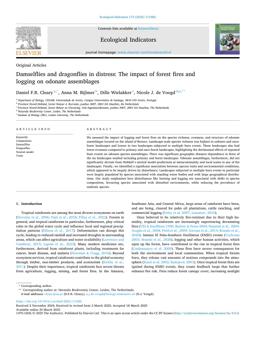2025-04-01
Damselflies and dragonflies in distress: The impact of forest fires and logging on odonate assemblages
Publication
Publication
Ecological Indicators , Volume 173 - Issue 113382
We assessed the impact of logging and forest fires on the species richness, evenness, and structure of odonate assemblages located on the island of Borneo. Landscape-scale species richness was highest in unburnt and once-burnt landscapes and lowest in two landscapes subjected to multiple burn events. These landscapes also had lower evenness compared to primary and once-burnt landscapes, highlighting the detrimental effects of repeated burn events on odonate species assemblages. There was significant geographic distance dependence in three of the six landscapes studied including primary and burnt landscapes. Odonate assemblages, furthermore, did not significantly deviate from Hubbell’s neutral model predictions at metacommunity and local scales in any of the landscapes. Finally, we identified a significant association between species traits and environmental conditions, which appeared to be largely driven by disturbance. Landscapes subjected to multiple burn events in particular were largely populated by species associated with standing water bodies and with large geographical distributions. Our study emphasises how disturbances like burning and logging are associated with shifts in species composition, favouring species associated with disturbed environments, while reducing the prevalence of endemic species.
| Additional Metadata | |
|---|---|
| , , , , | |
| doi.org/10.1016/j.ecolind.2025.113382 | |
| Ecological Indicators | |
| Released under the CC-BY 4.0 ("Attribution 4.0 International") License | |
| Organisation | Staff publications |
|
Cleary, Daniel F.R., Bijlmer, Anna M., Wielakker, Dille, & de Voogd, N. (2025). Damselflies and dragonflies in distress: The impact of forest fires and logging on odonate assemblages. Ecological Indicators, 173(113382). doi:10.1016/j.ecolind.2025.113382 |
|
